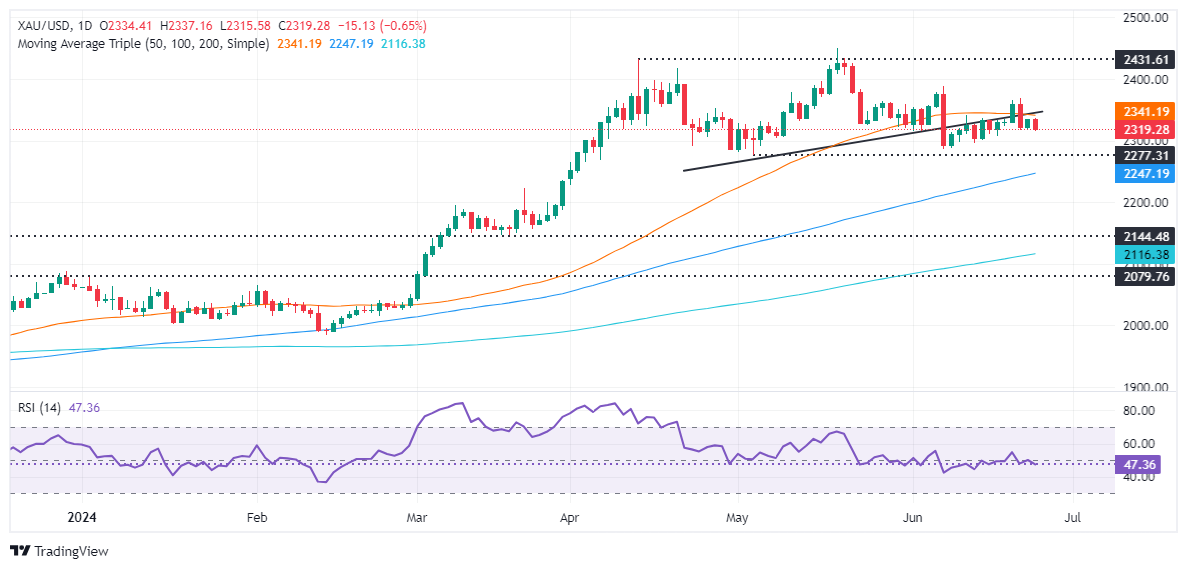Gold slips as strong USD follows Fed hawkish remarks

- Gold falls 0.59%, pressured by a recovering US Dollar and rising Treasury yields.
- Golden metal was pressured by Fed Governor Michelle Bowman’s hawkish remarks.
- Fed’s Lisa Cook is neutral, forecasting a sharp inflation decline next year.
- US Conference Board indicates declining consumer optimism, with diminished expectations for future income and business conditions.
Gold price tumbled after reaching a weekly high of $2,334 and fell as the Greenback staged a recovery underpinned by a minimal rise in US Treasury bond yields, spurred by Federal Reserve (Fed) Governor Michelle Bowman’s hawkish comments. The XAU/USD trades at $2,319, down 0.59%.
Bowman emphasized that monetary policy should remain steady for “some time” and would probably be enough to bring inflation down. She disregarded rate cuts this year and stated she’s willing to raise rates “should progress on inflation stall or even reverse.”
Recently, her colleague Lisa Cook adopted a more neutral stance, saying that inflation was most likely to fall “sharply” next year, adding that it would be necessary to ease policy to keep the Fed’s dual mandate more balanced.
Regarding economic data, the US Conference Board revealed that consumers are becoming less optimistic. According to the survey, consumers’ views of the current situation improved; nevertheless, “their expectations for both future income and business conditions weakened, weighing down the overall Expectations Index.”
In the meantime, traders are awaiting the release of the Fed’s preferred gauge for inflation, the Personal Consumption Expenditures (PCE) Price Index. If the data edges below the previous reading and estimates, it will reignite rate cut hopes for the year ahead.
Daily digest market movers: Gold price extends its losses on strong US Dollar
- US Dollar Index (DXY), which tracks the value of American currency against a basket of six other currencies, gained 0.13% to 105.61. In the meantime, US 10-year Treasury note yield shifted flat at 4.242%.
- On Monday, San Francisco Fed President Mary Daly leaned dovish as she said, “At this point, inflation is not the only risk we face,” she expressed worries about the labor market.
- Conference Board (CB) revealed that Consumer Confidence in June was 100.4, exceeding expectations, but missed May’s 101.3 rise.
- Headline PCE is expected to drop from 2.7% to 2.6% in yearly readings. Core is foreseen dipping from 2.8% to 2.6%.
- According to the CME FedWatch Tool, odds for a 25-basis-point Fed rate cut are at 59.5%, down from 61.1% last Monday.
- The December 2024 fed funds rate futures contract implies the Fed will ease policy by just 36 basis points (bps) toward the end of the year.
Technical analysis: Gold price retreats after testing Head-and-Shoulders neckline near $2,330
Gold price remains downwardly biased after forming a ‘bearish-engulfing’ chart pattern on Friday. This further validates the Head-and-Shoulders chart pattern, meaning that further downside is expected for the non-yielding metal.
The XAU/USD next support would be $2,300. Once cleared, XAU/USD would fall to $2,277, the May 3 low, followed by the March 21 high of $2,222. Further losses lie underneath, with sellers eyeing the Head-and-Shoulders chart pattern objective from $2,170 to $2,160.
Conversely, if Gold reclaims $2,350, that will expose additional key resistance levels like the June 7 cycle high of $2,387, ahead of challenging the $2,400 figure.
Gold FAQs
Gold has played a key role in human’s history as it has been widely used as a store of value and medium of exchange. Currently, apart from its shine and usage for jewelry, the precious metal is widely seen as a safe-haven asset, meaning that it is considered a good investment during turbulent times. Gold is also widely seen as a hedge against inflation and against depreciating currencies as it doesn’t rely on any specific issuer or government.
Central banks are the biggest Gold holders. In their aim to support their currencies in turbulent times, central banks tend to diversify their reserves and buy Gold to improve the perceived strength of the economy and the currency. High Gold reserves can be a source of trust for a country’s solvency. Central banks added 1,136 tonnes of Gold worth around $70 billion to their reserves in 2022, according to data from the World Gold Council. This is the highest yearly purchase since records began. Central banks from emerging economies such as China, India and Turkey are quickly increasing their Gold reserves.
Gold has an inverse correlation with the US Dollar and US Treasuries, which are both major reserve and safe-haven assets. When the Dollar depreciates, Gold tends to rise, enabling investors and central banks to diversify their assets in turbulent times. Gold is also inversely correlated with risk assets. A rally in the stock market tends to weaken Gold price, while sell-offs in riskier markets tend to favor the precious metal.
The price can move due to a wide range of factors. Geopolitical instability or fears of a deep recession can quickly make Gold price escalate due to its safe-haven status. As a yield-less asset, Gold tends to rise with lower interest rates, while higher cost of money usually weighs down on the yellow metal. Still, most moves depend on how the US Dollar (USD) behaves as the asset is priced in dollars (XAU/USD). A strong Dollar tends to keep the price of Gold controlled, whereas a weaker Dollar is likely to push Gold prices up.
